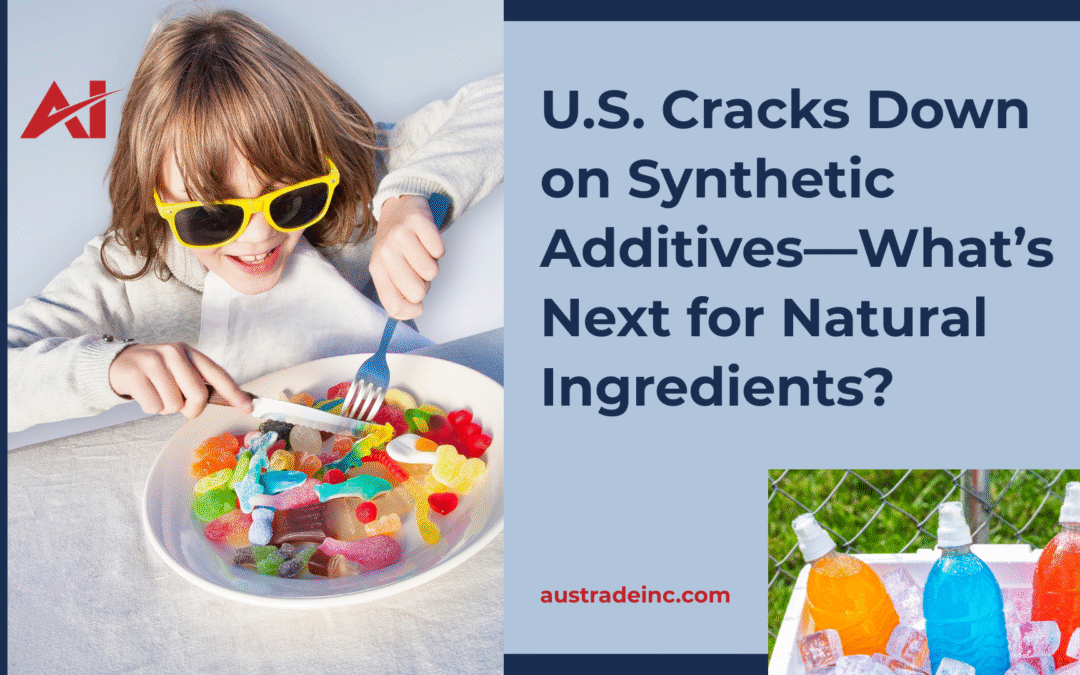U.S. Cracks Down on Synthetic Additives—What’s Next for Natural Ingredients?
Synthetic Additives Are Out; Natural Ingredients Are In
Health concerns over synthetic food dyes in the United States have grown in recent months, prompting drastic regulatory action. The Food and Drug Administration decided to ban Red Dye No. 3 earlier this year (effective January 15, 2027). This move highlights the growing scrutiny of artificial ingredients linked to potentially harmful health risks. With a national crackdown on synthetic additives—what’s next for natural ingredients?
FDA Commissioner Dr. Marty Makary shared concerns about a possible link between consumption of the dyes to obesity, diabetes, ADHD and other diseases. While they have not been definitively linked to cancer, concerns surround their potential impact on children’s behavior and overall health. It is also known that synthetic dyes lack nutritional value and essentially serve as empty calories.
Phasing Out Synthetic Additives
In response to growing health concerns, U.S. Health and Human Services Secretary Robert F. Kennedy Jr. announced a plan to remove eight petroleum-based synthetic food dyes by the end of 2026. Dyes include Green No. 3, Red No. 40, Yellow No. 5, Yellow No. 6, Blue No. 1, Blue No. 2 as well as Citrus Red No. 2 and Orange B. Federal officials are taking swift action to expedite authorization for removal of the latter two dyes within the coming months. This regulatory overhaul aims to establish a consistent national standard by addressing the patchwork of state-level regulations that have emerged.
- In 2024, California enacted Assembly Bill 2316 which bans the use of six synthetic dyes in K-12 school meals. These include Green No. 3, Red No. 40, Yellow No. 5, Yellow No. 6, Blue No. 1 and Blue No. 2.
- Earlier this year, West Virginia passed House Bill 2354 to become the first U.S. state to ban multiple synthetic dyes and preservatives from all foods sold statewide. Phase one prohibits the use of specified dyes in school nutrition programs as of August 1, 2025. Phase two extends the ban to all food products sold within the state by January 1, 2028.
HHS and the FDA have announced that they are working together with food manufacturers to remove the petroleum-based dyes. Given sensitive timelines, the FDA is accelerating the approval of natural color additives like calcium phosphate, Galdieria extract blue, gardenia blue, and butterfly pea flower extract as alternatives.
The Natural Ingredient Movement: Replacing Synthetic Ingredients with Alternative Sources
Beyond food dyes, several other synthetic ingredients are under scrutiny for potentially harmful health risks, including:
- Titanium Dioxide: Traditionally used to improve texture and opacity across various food and beverage applications, titanium dioxide was banned by the EU in 2022. It remains under scrutiny in the US for genuine health concerns as a potential carcinogen when inhaled in certain forms. Austrade’s Organic and Non GMO Rice Starch serves as an ideal clean label, allergen free alternative to titanium dioxide. It particularly complements the following applications: dairy and alternatives, chewing gum and natural confectionery coatings.
- Potassium Bromate: Often used as a dough conditioner in flour applications, potassium bromate is classified as a potential carcinogen. While it remains legal in the US, other countries have voluntarily banned its use. Natural alternatives include various enzyme combinations as well as Austrade’s Vital Wheat Gluten mixed with Austrade’s Organic and Non GMO Lecithin. Combining lecithin and vital wheat gluten is an excellent way to improve volume, dough strength and shelf life without adding any chemicals or synthetic substances. When supplementing with vital wheat gluten, it’s important to adjust formulas to about 1.5x its weight in additional water. This particular substitution works well in applications such as high protein bread, dough, pizza and bagels.
These developments indicate a growing trend toward re-evaluating the safety of food ingredients and a shift toward natural alternatives. Just last week, PepsiCo announced plans to phaseout a range of artificial ingredients from the US supply chain by the end of 2025. Not only is the company working to eliminate petroleum-based food dyes a full year ahead of schedule—they are opting to replace other artificial ingredients as well. The move to implement more natural alternative ingredients across formulations shows a commitment to quality and consumer health. Brands that reformulate with natural sources ahead of federal deadlines are more likely to resonate with consumers.
Austrade Inc: Your Trusted Ingredient Partner
As the regulatory landscape for food safety and standards continues to evolve, the demand for natural products is expected to grow. Brands seeking to create healthy, natural products that align with evolving consumer demands will thrive. Beverage brands may consider reformulating a functional beverage to reduce sugar content while maintaining viscosity. Food brands may opt to enhance the protein content of a snack innovation without altering texture or flavor. No matter the formulation, our expertise and dedication to transparency and sustainable innovation positions us as a trusted partner.
Contact your leading Organic & Non-GMO ingredient company today and let us help with your next project!
